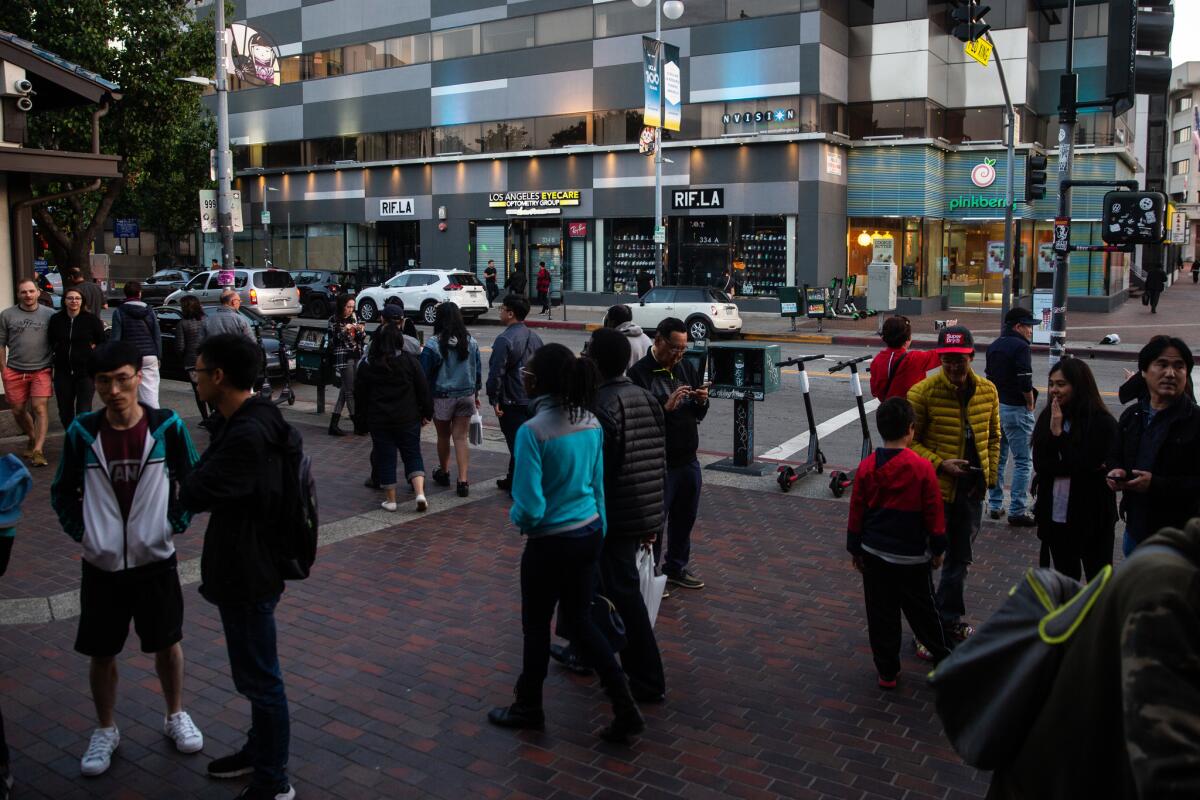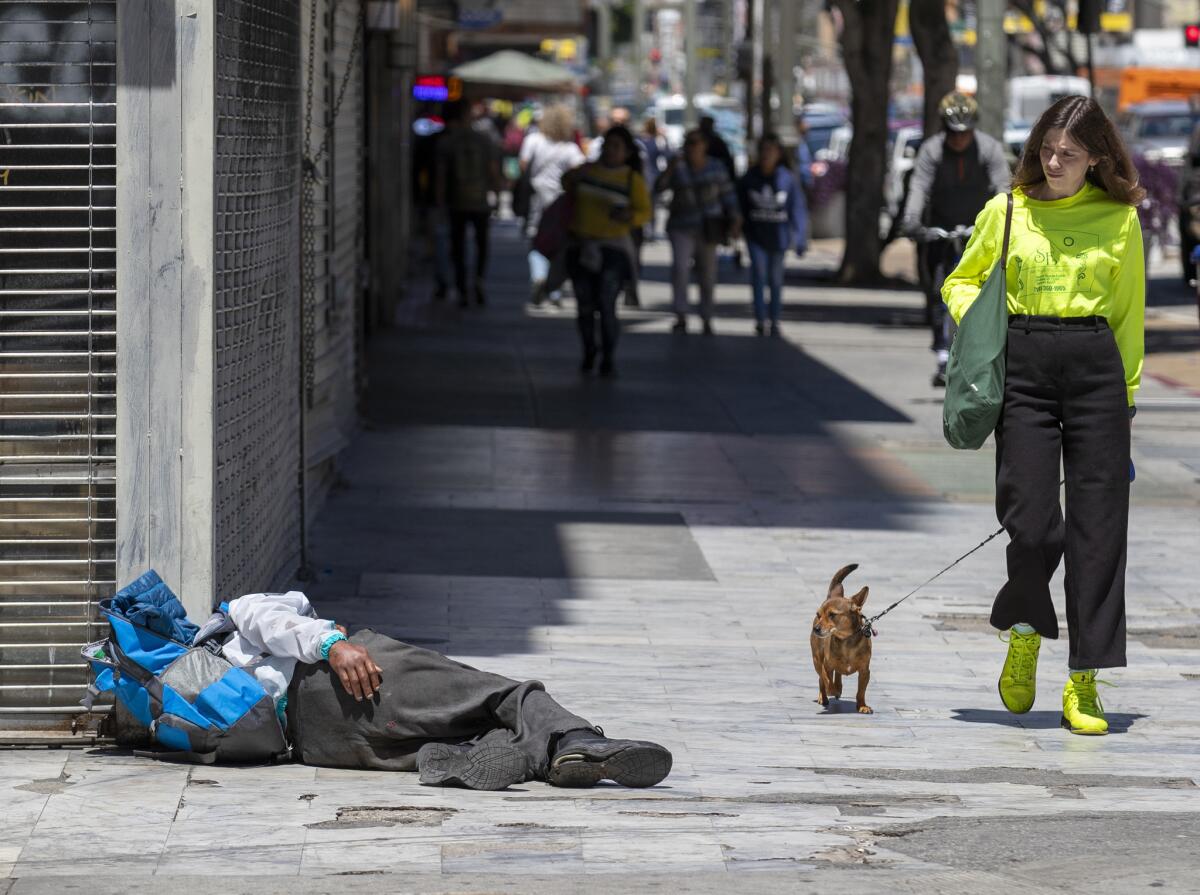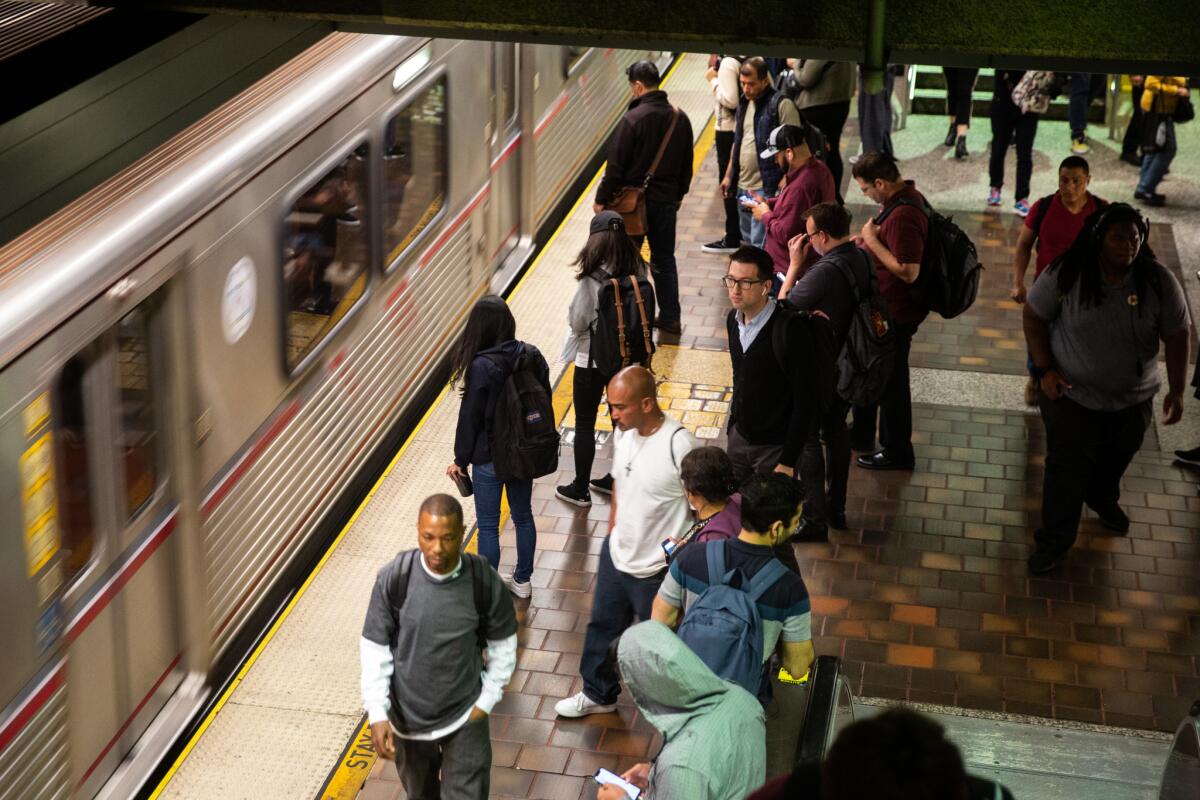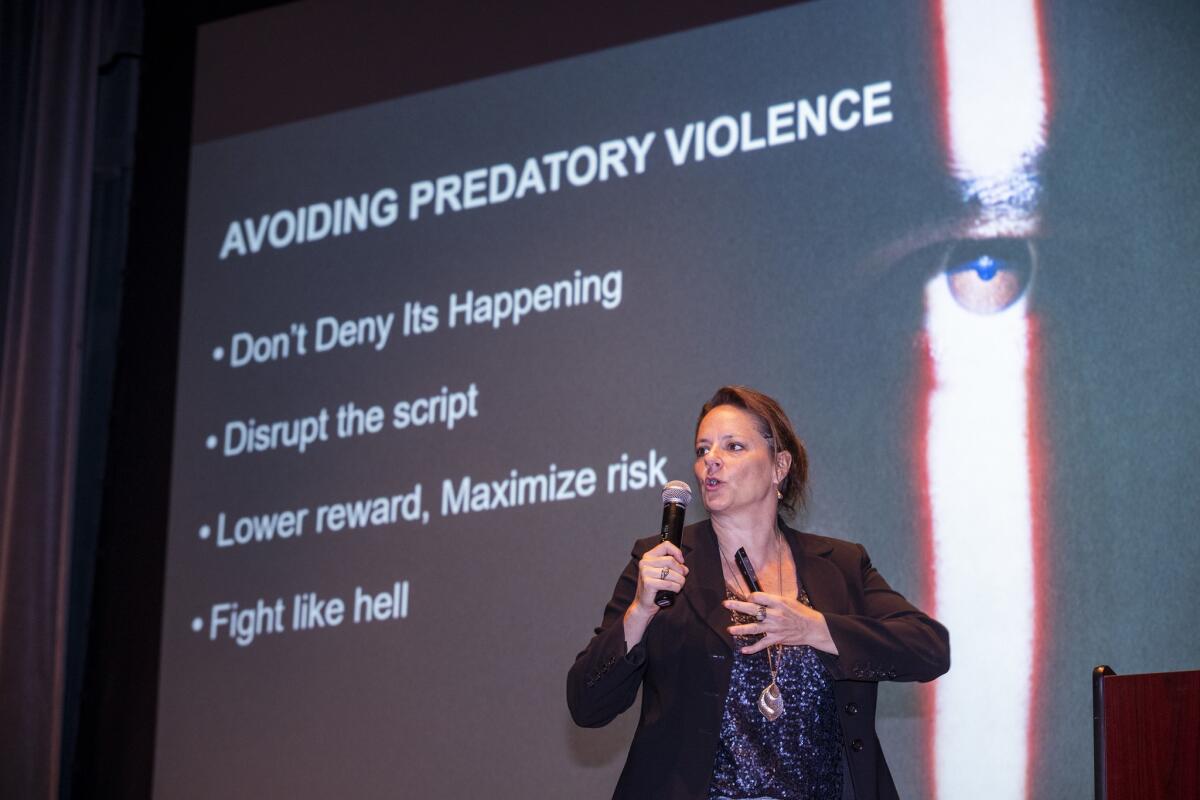City Beat: The streets of L.A. can seem scary, but we need to separate fact from fear

L.A. Times Today airs Monday through Friday at 7 p.m. and 10 p.m. on Spectrum News 1.
Let’s play a game, the self-defense instructor says on the Red Line. Let’s think like the bad guy. Let’s scout for the best victims.
We are on a downtown train, heading to a class she’s teaching. I’ve been to one already. It’s easy to spot what I’m looking for.
A young woman in a hoodie and jeans stands near a door on the platform side. Her eyes are locked on the screen of her cellphone, loosely held in one hand, while her other hand clutches the pole. She has wireless headphones in her ears. Her knapsack which at first sat securely on both shoulders now is gently swaying off one.
If I were a bad guy, I’m thinking, I would wait until the train pulls into the next station. Then I’d yank off the knapsack, grab the cellphone, hightail it out the open door.
I’m staring intently at her, but she is oblivious. Me, I’ve absorbed the instructor’s hyper-vigilant eye.
I’ve even flipped the coin and, for extra credit, have been trying to pick out potential troublemakers. Don’t base it on looks, race, characteristics, she’s told me. Black, white, homeless — who cares? Focus on behavior. Is anyone standing a little too close to anyone? Breathing funny? Rubbing at his or her face in a sort of grooming?
I’m looking, not seeing anything, except that the guy with the dreadlocks, facing me two feet away, has a spaced-out stare and cool patent-leather-shiny black sneakers. But then, as I’m staring down Cellphone Girl again, trying to will her eyes up, I see Dreadlocks’ dart ever so briefly toward my own pack, which I quickly hug to my chest. As I’m stepping off the train, he’s moving toward me, taking one giant leap to close the gap.

We in Los Angeles are a little tense and jumpy right now. Our nerves are jangled. We’re anxious. We look out our car, bus and train windows and we see things we don’t like. People lying on our sidewalks. Tents under our freeways, in some neighborhoods on every blade of spare public grass.
People are hurting. They have no place to go. And yes, some of them clearly have drug or mental problems whose manifestations put us on edge. But when we’re scared sometimes, we forget a lot.
L.A. overall is safer now than it’s been in decades, according to the LAPD — unless you happen to be homeless, in which case you’re very vulnerable. Meanwhile, so many of us who are far less vulnerable have adopted a siege mentality.
We all know what it’s like to walk down a street in fear. We pick up the pace, eyes forward. We don’t greet or acknowledge in any way those we’re anxious to rush past.
Maybe, too, we forget to remember that they’re not one big blob, they’re people — individuals just like you and me. Some good, some bad, some very, very sick, some simply driven to their sidewalk spots by the forces of our society.
I worry about that often when I read the neighborhood message boards. All that “out, out, out, let’s get them all out of here” stuff.
I understand. I struggle with my own feelings, too. I just want us to do a better job of sorting one person from the next.

That’s why I was excited when I happened upon a notice of the self-defense instructor’s street smarts course, which promised to decode “the human and social patterns in the urban landscape.”
“Asphalt Anthropology: Essential Safety Tactics for City Life” seemed to offer a helpful way to examine our city and its people.
I knew I was on the right path when she was very wary of letting me sit in — until I assured her that my intention wasn’t to use her class in this column to write some screed about scary L.A.
That’s the opposite, she said, of what she has in mind. She’s a martial artist, yes. But she’s an urban explorer. And she believes that the more people know about how to assess what they’re seeing on their streets, the more comfortable they’ll be going out into them and enjoying the city.
We in Los Angeles are a little tense and jumpy right now. Our nerves are jangled. We’re anxious.
Street smarts get ingrained almost at birth in cities in which people press close on crowded trains, buses and sidewalks. Spending time with Beverly Baker, I feel mine being honed, like a blunt knife sharpened.
Zip the top of your bag. Don’t flash your cash. Make sure you have on shoes you can move in.
In Los Angeles, Baker has a day job in an office, but she is carving out a niche teaching sophisticated street smarts to adults who feel a great and growing — sometimes very pressing — need for it.
In the past year, she has taught it in small and big groups, to apartment dwellers and tour guides, to staff at the Fashion Institute of Design & Merchandising, to citizens enrolled in the LAPD’s Central Area Community Police Academy.

It’s not about fear mongering, she says. It’s about making people understand that they are strong and capable and that they have built-in tools to survive. It’s less showing them how to get out of a bad situation than helping them learn skills to protect themselves and avoid getting into one in the first place.
This is territory that Baker knows well. She has studied how to deescalate conflict under Rory Miller, a well-known former corrections officer and martial artist who has written extensively about preparing for and handling violence. She volunteers to escort women at a clinic that performs abortions, and is used to negotiating different points of view. She was once in an abusive relationship that even she — protected by her physical training — wasn’t prepared for emotionally. She also has an undergraduate degree in sociology.
Baker has been practicing various forms of martial arts since her teens. She boxes and does Krav Maga. She’s been teaching self-defense for 20 years. All of that work goes into a class she teaches to women at the L.A. Mission, to women who have the most urgent of needs to make sure they know how to fight back.

“Asphalt Anthropology,” however, involves no kicks, no keys wedged between fingers for jabbing. It’s all about being alert, being smart, observing, picking up clues.
Don’t turn your back on a potential threat. Use window reflections as mirrors to spot what’s around you.
In neighborhoods like Hollywood and downtown L.A., where Baker has taught most of her classes, there are the police stats and then what the eyes see. Tents mushrooming down the sidewalks. Panhandlers blocking the way. In her sessions, men and women alike often tell Baker of the tension they feel, never knowing what will come at them next.
There are clues, she says. People who are up to no good always have their tells. The way they’re using their hands and arms. The way they keep asking questions even when you indicate no interest in answering them. The way they glance at what they’re after and check around to see if anyone’s around to witness what they are about to do. Get to know what they are, she says. Look for them. And grow the personal bubble around you until it’s big enough to spot what’s heading toward you long before it can ever arrive.
“Once you start paying attention, the world’s actually a lot less scary,” she tells a small group gathered on a recent weeknight in a luxury building’s private theater. “Once you know what to look for.”
City Beat: The loneliness problem in L.A. starts with traffic. Could it end with a walk? »
A few days later, she is facing more than 150 employees in a big auditorium at the South Park headquarters of the Girl Scouts of Greater Los Angeles. People have come from all over the area on a weekday morning. They are mostly, but not exclusively, women. Women, she tells them, usually try to be polite and nice. Sometimes that isn’t what’s called for. Sometimes bad guys are watching for the door that politeness leaves open.

On a big screen on a big TV, she shows them videos straight from the news — of random street violence in Hollywood and downtown. She plays them more than once, asking the group to help dissect them. Could the older man who was shoved in the street have noted his aggressor earlier? Was that girl holding her cellphone when the shirtless guy whacked her in the head?
Karen Masini, 34, who works in the Girl Scouts headquarters and lives nearby, is one of the many people who raise their hands and talk about their worries. She’s out there on the streets with her baby in his stroller. And she can get nervous — even though she loves almost everything else about downtown L.A.
“I don’t fear the homeless,” she told me afterward. “I fear when somebody is unstable and unpredictable.”
Baker, she said, gave her some good tips — and confirmed her own good instincts.
“I don’t look at my phone. I watch carefully,” she said. “I used to not want to listen to the all the yellings so I’d put on headphones. Now I know that I need to see and hear it all.”
Eyes up. Phone away. Never hug a corner. Position yourself to see what’s on the other side.
Nita Lelyveld wants to know your L.A. story. Email her at [email protected].
More to Read
Sign up for Essential California
The most important California stories and recommendations in your inbox every morning.
You may occasionally receive promotional content from the Los Angeles Times.











